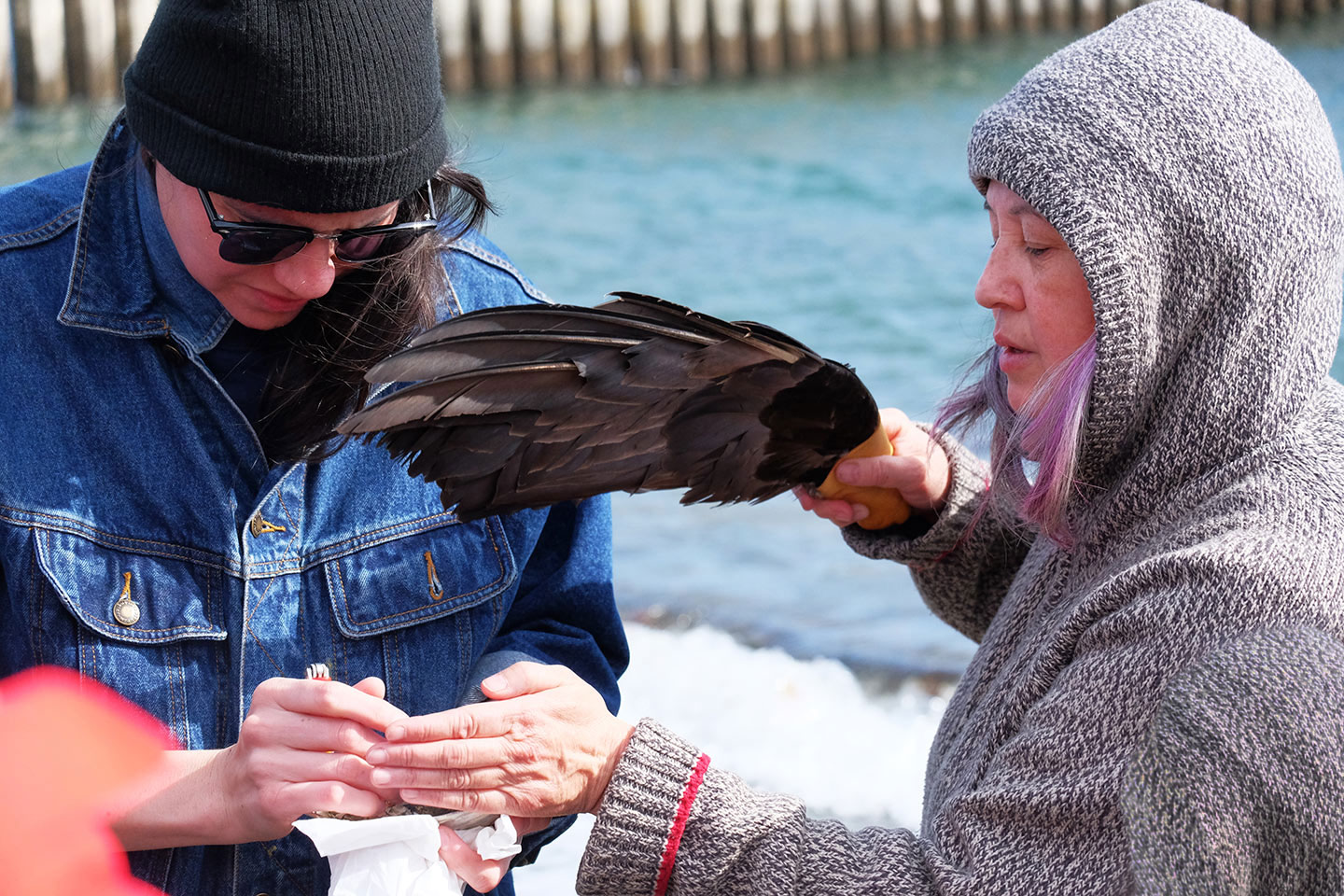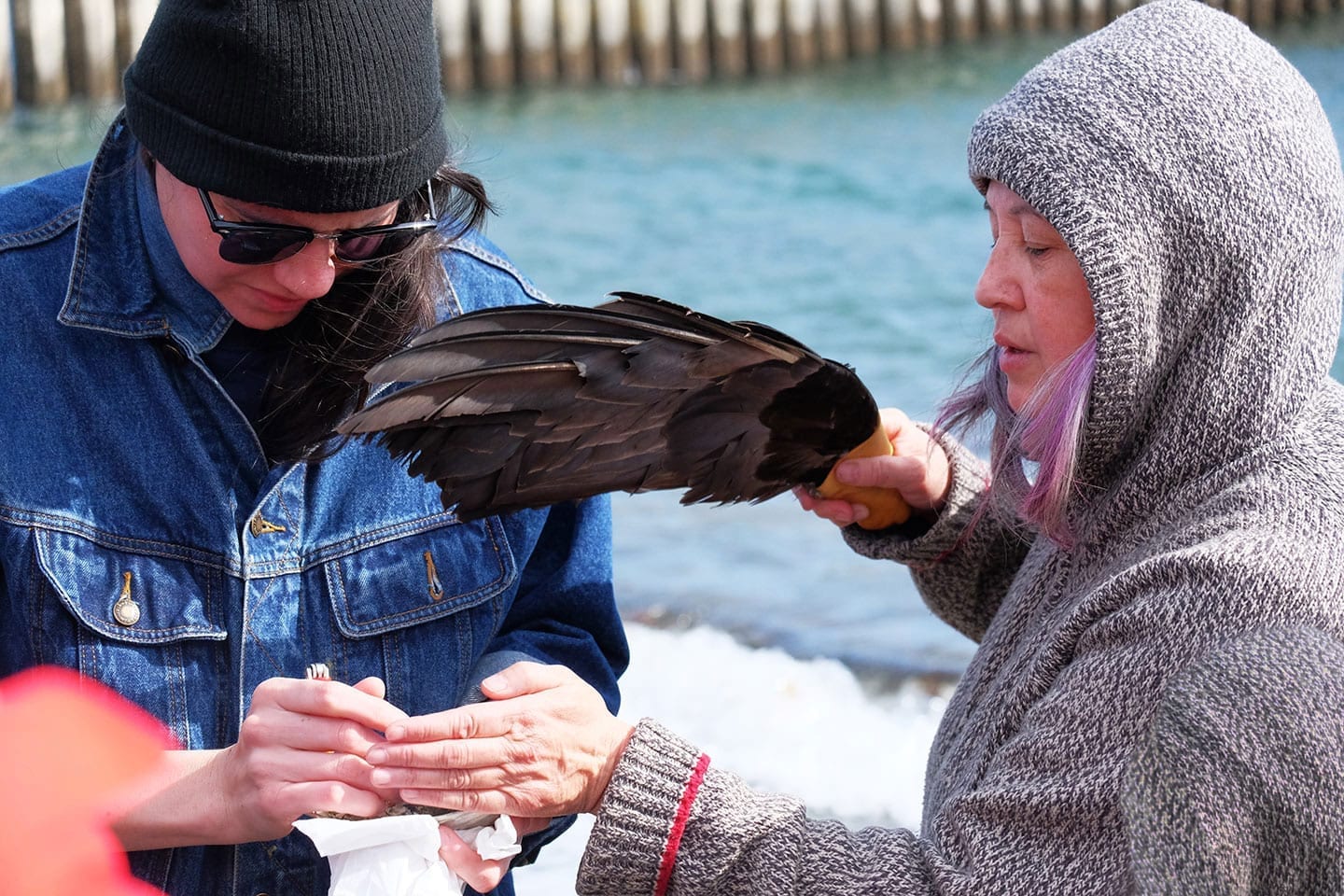
“Ceremonial activism” with Cease Wyss (Skwxwu7mesh/Sto:lo/Metis/ Hawaiian/Swiss) and Anne Riley (Cree and Dene) at the spring 2017 MFAIA residency, Puget Sound, Fort Worden, Washington. Photo: Goddard College
Spurred on by the resurgence of indigenous movements, a profound inquiry into indigenous and decolonial practices has spread rapidly throughout the Americas. This resurgence has generated both institutional critique of the colonial roots of Western culture, as well as new art forms grounded in Indigenous sovereignty. The Indigenous and Decolonial Art Concentration, offered in Goddard’s Washington-based low-residency MFA in Interdisciplinary Arts Program, is one of the first academic initiatives in the United States designed to bring together Indigenous, settler, and forcibly displaced non-indigenous artists expressly to expand practices of Indigenous resurgence and solidarity practices.
Both Native and non-Native students alike in the concentration will be encouraged and guided to deepen the traditional practices grounded in their cultures, explore the many complex ways that living traditions intersect with contemporary art practices, hone their craft,and/or expand their audiences. The range of art practices supported by the concentration is as vast as the subject matter itself. The MFA in Interdisciplinary Arts is committed to expanding the collective of regional and national inter-tribal representatives—including local elders, wisdom and knowledge keepers—to contribute to the development of the Indigenous and Decolonial Art Concentration as members of the Concentration’s Circle of Advisors.
Cohorts enrolled in this concentration will participate in collaborative learning opportunities, experiential, textual, and multimedia based which may take the form of webinar-style group studies and field trips to museums, longhouses and other tribal centers in the region. Concentration students will engage with contemporary Indigenous thinkers, activists, artists, and academics who include or reference traditional knowledge practices and also are paving the way for continued integration of non-traditional forms with traditional frameworks in relevant, creative ways.
About the MFA
The Master of Fine Arts in Interdisciplinary Arts (MFAIA) engages artists from a variety of practices, including visual arts, dance, music, theater, performance art, social practice, design, digital media, and the literary arts, to study in a rigorous interdisciplinary context. Students not only have the opportunity to work across artistic disciplines both individually and in collaboration with peers, but the MFAIA also encourages broader interdisciplinary inquiry, enabling dialogue among art and science, social science, humanities, and other systems of knowledge.
One of the only graduate programs in the world committed to art as a transformational practice, the MFAIA is designed to support artists with diverse life experiences and goals ranging from the social, political, to the aesthetic, spiritual or autobiographical. Our learning community supports the development of a robust lifelong art practice. We envision artmaking as a form of critical thinking, that integrates research and interdisciplinary problem-solving and engages ethically in public contexts.
About the Residency Site
The Washington (WA) campus is the traditional home of the Hoh, Quileute, Jamestown S’klallam, Port Gamble S’klallam, Makah, Quinault, and Lower Elwha Klallam and is located at the edge of Puget Sound in Fort Worden State Park and nearby the town of Port Townsend. Fort Worden is home to many arts organizations, including Centrum (which organizes popular jazz and blues music festivals, writers’ symposia and workshops, and artists’ residencies throughout the year), Madrona MindBody Institute, Copper Canyon Press, the Port Townsend Woodworking School, and a wealth of other arts and cultural organizations. Port Townsend has an international reputation for the arts, with its Writers conference, Film Festival, Playwrights festival, etc. Currently Fort Worden is being developed as a Center for Lifelong Learning.
About the Low-Residency Model
Each semester begins with an 8-day residency, which is like an artist residency or retreat with academic ‘training’ rolled into one. Students, faculty and guest artists arrive from across the country, Canada and beyond, to explore a range of interdisciplinary questions, challenges and contemporary issues. During residency, students create a Study Plan, then after the residency, students exchange five (5) “packets” over the course of the semester at three-week intervals of the 15-week semester via email or other formats agreed upon with your advisor, conversations with your advisor and/or cohort.
Faculty
The core concentration faculty have longstanding presence in the college and bring to their work a host of professional skills and disciplinary areas. Fields of expertise include indigenous contemporary art practice and living traditions, decolonial aesthetics, migratory aesthetics, community engagement, among other areas. Much of the work and interests of the faculty is in keeping with the college’s activist and social justice mission. The faculty also have a range of international experience both in terms of work and research conducted in other areas of the world and in terms of their own lived experiences.
Concentration Faculty
Jamie Figueroa (Taíno), Boricua by way of Ohio, and long time resident of northern New Mexico, explores identity, familial relationships, place, culture, and ancestry. A two time graduate of the Institute of American Indian Arts, (BFA and MFA in Creative Writing), she publishes across genres including fiction, creative nonfiction, and poetry. Her collaborative work in the community facilitates engaging underrepresented voices and highlighting intergenerational, multi-racial and multi-ethnic, gender and sexuality difference and equality. At present, she facilitates modern myth making for personal and collective restoration and healing.
Devora Neumark (Interim Lead Faculty Coordinator) is an interdisciplinary artist-researcher, performance artist and community-engaged practitioner with extensive experience working with the Assembly of First Nations of Quebec and Labrador’s Employment and Training Commission and the Montreal Urban Aboriginal Community Strategy Network.
Petra Kuppers is a community performance artist. Her work engages with space-based and decolonial knowing, predominantly through learning to live well from Anishinaabe traditions in her settler home, Michigan.
Laiwan is an interdisciplinary visual artist and writer who has been exploring the trajectory of neo-colonialism found in digital technologies, and countering these with explorations in embodiment, improvisation, poetics, and somatic ways of knowing.
JuPong Lin (Program Director), works at the edges of art and activism as a community performance artist and advocate for decolonial cultural reclamation and climate justice.
Concentration Requirements
In addition to engaging with the general MFAIA degree criteria, students pursuing the Indigenous and Decolonial Art Concentration will:
- Enroll in the MFAIA concentration for a minimum of four semesters.
- Build a significant body of creative work engaging a indigenous and/or decolonial praxis each semester.
- Develop 45-50 short critical annotations in dialogue with textual resources and live events; including bibliographic citations, short annotations, and evidence of critical engagement.
- Develop three critical essays (two 5-pages, one 20-pages) that critically explore the context of one’s practice.
- Participate in at least two collaborative learning opportunities (co-learning or other group studies.) and a sequence of residency workshops.
- As the means of fulfilling the MFAIA portfolio requirement, concentrators must prepare a document that includes evidence of a significant body of creative work developed over a student’s time in the program; at least two extensive pieces of critical writing; and at least 20 annotations of the most significant resources used in one’s graduate study.
